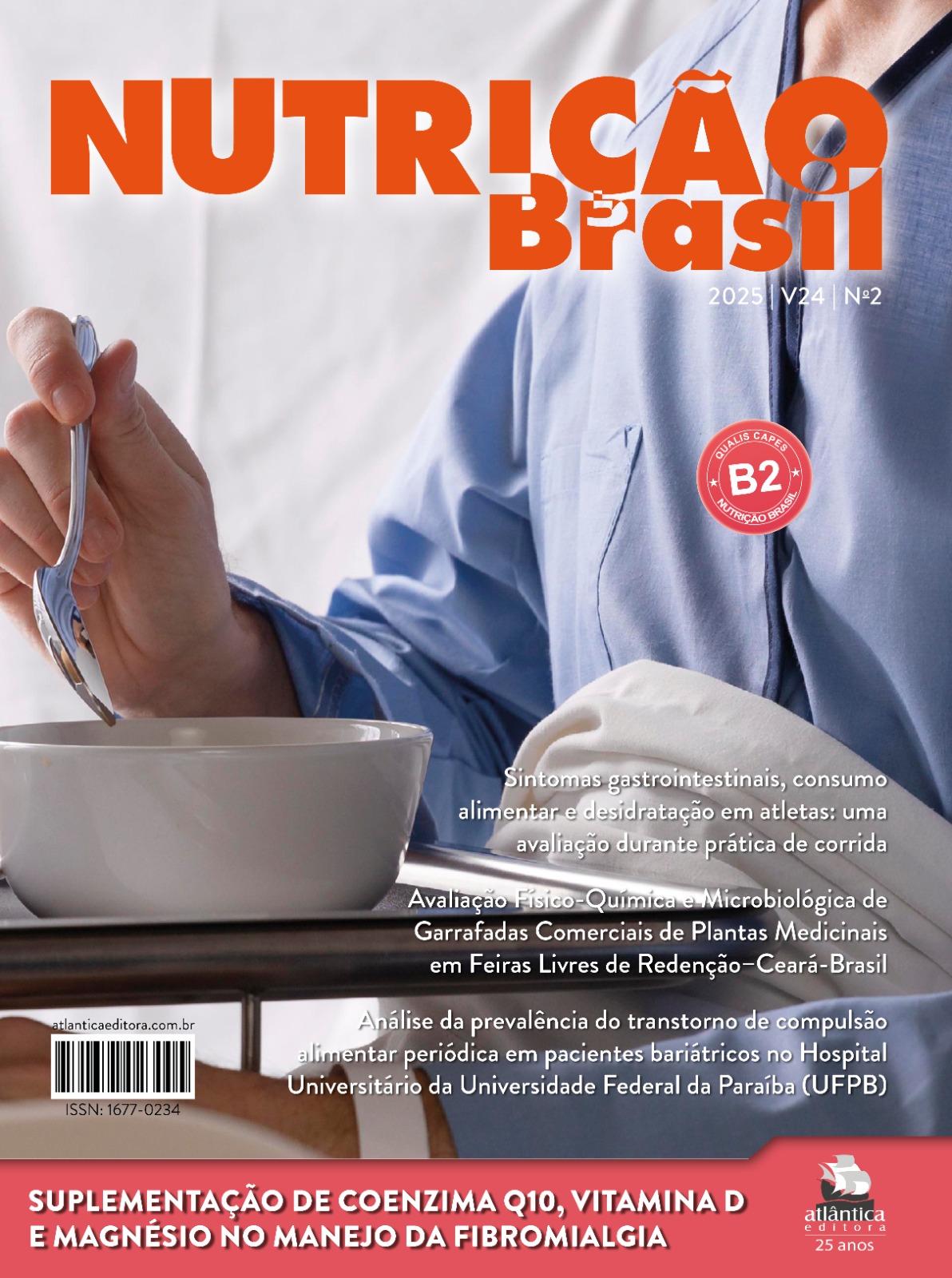The impact of omega-3 fatty acid intake on reducing irritability and anxiety in women with premenstrual syndrome: biochemical mechanisms and nutritional strategies
DOI:
https://doi.org/10.62827/nb.v24i2.3067Keywords:
Premenstrual Syndrome; Fatty Acids; Anxiety; Nutrology.Abstract
Introduction: Premenstrual Syndrome (PMS) is a functional disorder characterized by emotional and physical symptoms that negatively affect women's quality of life. Evidence suggests that omega-3 fatty acids, particularly eicosapentaenoic acid (EPA) and docosahexaenoic acid (DHA), can modulate inflammatory and neuromolecular processes associated with irritability and anxiety, prevalent symptoms in PMS. Objective: To analyze, through a narrative literature review, the effects of EPA and DHA supplementation on the emotional symptoms of PMS, focusing on the reduction of irritability and anxiety. Methods: Narrative literature review that analyzed 14 studies published between 2015 and 2025, selected from PubMed, SciELO, ScienceDirect, Cochrane Library, and Google Scholar databases, emphasizing the relationship between omega-3 supplementation and PMS. The analysis considered study design, doses, intervention duration, participant characteristics, and main findings. Results: Omega-3 supplementation showed positive effects in reducing irritability and anxiety, attributed to modulation of systemic inflammation and serotonergic and dopaminergic neurotransmission. Doses above 1000 mg/day, for at least three menstrual cycles, showed greater efficacy. However, methodological heterogeneity limits the generalization of the results and reinforces the need for more robust studies. Conclusion: EPA and DHA supplementation is a safe and potentially effective nutritional alternative for attenuating the emotional symptoms of PMS, especially irritability and anxiety. However, clinical application should consider individual factors such as dietary patterns, body composition, and contraceptive use. Further longitudinal studies with greater methodological rigor are necessary to consolidate clinical guidelines.
References
Mohammadi MM, Mirzaei K, Askari G, Rouhani MH, Hosseini SA. Effect of omega-3 fatty acids on premenstrual syndrome: a systematic review and meta-analysis [Internet]. J Obstet Gynaecol Res. 2022 Jun;48(6):1293–305. [cited 2025 May 28]. Available from: https://doi.org/10.1111/jog.15217
Mohammadi MM, Mirjalili R, Faraji A. The impact of omega-3 polyunsaturated fatty acids on primary dysmenorrhea: a systematic review and meta-analysis of randomized clinical trials [Internet]. Eur J Clin Pharmacol. 2022 May;78(5):721–31. [cited 2025 May 28]. Available from: https://doi.org/10.1007/s00228-021-03263-1
Snipe RMJ, Brelis B, Kappas C, Young JK, Eishold L, Chui JM, et al. Long-chain omega-3 polyunsaturated fatty acids as a potential treatment to reduce dysmenorrhea pain: a systematic literature review and meta-analysis [Internet]. Nutr Diet. 2024 Feb;81(1):94–106. [cited 2025 May 28]. Available from: https://doi.org/10.1111/1747-0080.12835
Fernandes MFS, Oliveira CR, Sureira TM, Freitas FF. Efeito da ingestão de ômega-3 sobre a ansiedade em estudantes universitários [Internet]. BRASPEN J. 2017;32(2):140–3. [cited 2025 May 28]. Available from: https://www.braspen.org.br/banco-de-artigos
Neumann KRS, Souza LSC. Predominância estrogênica e manejo nutricional [Internet]. Rev Multidiscip Nordeste Mineiro. 2025 Mar;6(1):1–16. [cited 2025 May 28]. Available from: https://doi.org/10.61164/rmnm.v6i1.3705
Oboza P, Ogarek N, Wójtowicz M, Rhaiem TB, Olszanecka-Glinianowicz M, Kocełak P. Relationships between premenstrual syndrome (PMS) and diet composition, dietary patterns and eating behaviors [Internet]. Nutrients. 2024;16(12):1911. [cited 2025 May 28]. Available from: https://doi.org/10.3390/nu16121911
Thakur H, Pareek P, Sayyad MG, Otiv S. Association of premenstrual syndrome with adiposity and nutrient intake among young Indian women [Internet]. Int J Womens Health. 2022;14:665–75. [cited 2025 May 28]. Available from: https://doi.org/10.2147/IJWH.S364124
Pannain GD, Brum VDOR, Abreu MMA, Lima GB. Epidemiological survey on the perception of adverse effects in women using contraceptive methods in Brazil [Internet]. Rev Bras Ginecol Obstet. 2022;44:25–31. [cited 2025 May 28]. Available from: https://doi.org/10.1055/s-0041-1730457
Alves RMSR, Maynard DC. O consumo alimentar e a síndrome pré-menstrual (SPM) entre mulheres do Distrito Federal (DF) [Internet]. Res Soc Dev. 2022;11(17):e36111738670. [cited 2025 May 28]. Available from: https://doi.org/10.33448/rsd-v11i17.38670
Stefanello FPS, Pasqualotti A, Pichler NA. Análise do consumo de alimentos fontes de ômega-3 por participantes de grupos de convivência [Internet]. Rev Bras Geriatr Gerontol. 2019;22(6):e190287. [cited 2025 May 28]. Available from: https://doi.org/10.1590/1981-22562019022.190287
Pramiu do Nascimento DC, Bender S, Miotto Bernardi D. Efeitos da suplementação de ácidos graxos ômega-3 na ansiedade: uma revisão recente [Internet]. Rev Faz Ciênc. 2024;26(44). [cited 2025 May 28]. Available from: https://doi.org/10.48075/rfc.v26i44.33454
Meth EMS, Nôga DA, Dubol M, Xue P, Sundström-Poromaa I, Bento C. O impacto da farmacoterapia para transtorno disfórico pré-menstrual no sono [Internet]. Sleep Med Rev. 2025 Apr;80:102069. [cited 2025 May 28]. Available from: https://doi.org/10.1016/j.smrv.2025.102069
Jespersen C, Lauritsen MP, Frokjaer VG, Schroll JB. Inibidores seletivos da recaptação da serotonina para síndrome pré-menstrual e transtorno disfórico pré-menstrual [Internet]. Cochrane Database Syst Rev. 2024 Aug 14;8(8):CD001396. [cited 2025 May 28]. Available from: https://doi.org/10.1002/14651858.CD001396.pub4
Brown N, Martin D, Waldron M, Bruinvels G, Farrant L, Fairchild R. Nutritional practices to manage menstrual cycle related symptoms: a systematic review [Internet]. Nutr Res Rev. 2024 Dec;37(2):352–75. [cited 2025 May 28]. Available from: https://doi.org/10.1017/S095442242300022
Downloads
Published
Issue
Section
License
Copyright (c) 2025 Maria Andrezza Bezerra Cavalcante, Monique Maria Lucena Suruagy do Amaral Aguiar (Autor)

This work is licensed under a Creative Commons Attribution 4.0 International License.
Autores que publicam nesta revista concordam com os seguintes termos:
Autores mantém os direitos autorais e concedem à revista o direito de primeira publicação, com o trabalho simultaneamente licenciado sob a Licença Creative Commons Attribution 4.0 que permite o compartilhamento do trabalho com reconhecimento da autoria e publicação inicial nesta revista.
Autores têm autorização para distribuição não-exclusiva da versão do trabalho publicada nesta revista (ex.: publicar em repositório institucional ou como capítulo de livro), com reconhecimento de autoria e publicação inicial nesta revista.





